Enter the woods at the kiosk at the east end of the parking lot and turn left onto the white-blazed Glacial Trail, which parallels an old stone wall. You’ll soon reach a fork, where you should bear right to continue on the trail. The Glacial Trail climbs gradually on switchbacks through a deciduous forest, then levels off and begins to descend. The trail parallels Goodale Road, occasionally...
Hike Description:
Enter the woods at the kiosk at the east end of the parking lot and turn left onto the white-blazed Glacial Trail, which parallels an old stone wall. You’ll soon reach a fork, where you should bear right to continue on the trail. The Glacial Trail climbs gradually on switchbacks through a deciduous forest, then levels off and begins to descend. The trail parallels Goodale Road, occasionally visible below on the left. Side trails leave on the right and then on the left, but you should continue ahead on the main white-blazed trail.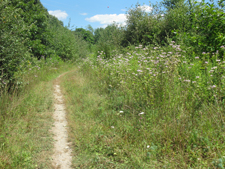
After climbing a little, the Glacial Trail curves away from the road and follows a winding route, soon beginning a gradual descent. After descending more steeply, you’ll pass several interesting rock formations on both sides of the trail. The trail then bears left at the next intersection and soon enters a successional meadow, with many wildflowers.
Towards the end of the meadow, the trail bears right and begins to parallel Lake Aeroflex, on the left. Be alert for a sharp left turn (marked by an arrow), where the white-blazed trail leaves the woods road it has been following and begins to follow a narrow footpath along the shore of the lake. Although the trail is only a few feet from the shore, there is rather dense vegetation between the trail and the lake, allowing only glimpses of the lake from this section of the trail.
After following the lakeshore for about 0.4 mile, you’ll reach a dock that extends into Lake Aeroflex – the deepest natural lake in New Jersey -- providing your first unobstructed view of the lake. Another viewpoint over the lake, a short distance beyond, is marked by an abandoned stone fireplace. You’ll pass several trail junctions; in each case, bear left to continue along the lake.
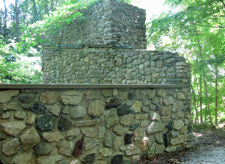 A little further along, you’ll pass a stone chimney on the right. This is a remnant of Camp Wawayanda, a YMCA camp that operated on Lake Aeroflex from 1917 to 1954. The trail now widens into a woods road and passes a number of open grassy areas.
A little further along, you’ll pass a stone chimney on the right. This is a remnant of Camp Wawayanda, a YMCA camp that operated on Lake Aeroflex from 1917 to 1954. The trail now widens into a woods road and passes a number of open grassy areas.
Near the southern end of Lake Aeroflex, the Glacial Trail ends at a paved road, with the gated Aeroflex-Andover Airport on the left. Turn right onto the paved road and bear right at the fork. A short distance ahead, bear left onto a gravel road, then immediately bear right, passing an old white wooden garage on the left. Follow a gravel road uphill, passing the ruin of a stone building (formerly used by Camp Wawayanda) on the right. Bear left at the next intersection and head uphill. At the top of the rise, you’ll intersect the blue-blazed Limestone Trail.
Turn left onto the Limestone Trail, which follows a winding, undulating route. At one point, you’ll pass between cliffs on the right and a hemlock grove on the left. In about a third of a mile, you’ll cross a yellow-blazed paved road and continue ahead on the trail.
In another half mile, you’ll notice a wetland on the right. When you come to a fork, bear right (do not follow the arrow that points to the left), and you’ll soon reach the end of the blue-blazed Limestone Trail at a junction with the unmarked Sussex Branch Trail.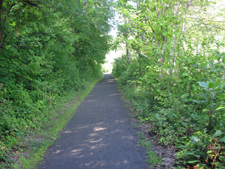
Turn right onto the Sussex Branch Trail, the right-of-way of the former Sussex Branch of the Lackawanna Railroad, built in 1854 and abandoned in 1966. At first, the trail (a wide cinder path) runs between White’s Pond, on the left, and a wetland on the right, but it soon enters a deciduous forest and, in 0.6 mile, it crosses Goodale Road. Continue to follow the Sussex Branch Trail along the left side of the road until you reach the park entrance road, where you turn right into the parking lot to return to the start of the hike.
Publication: Submitted by Daniel Chazin on 08/21/2014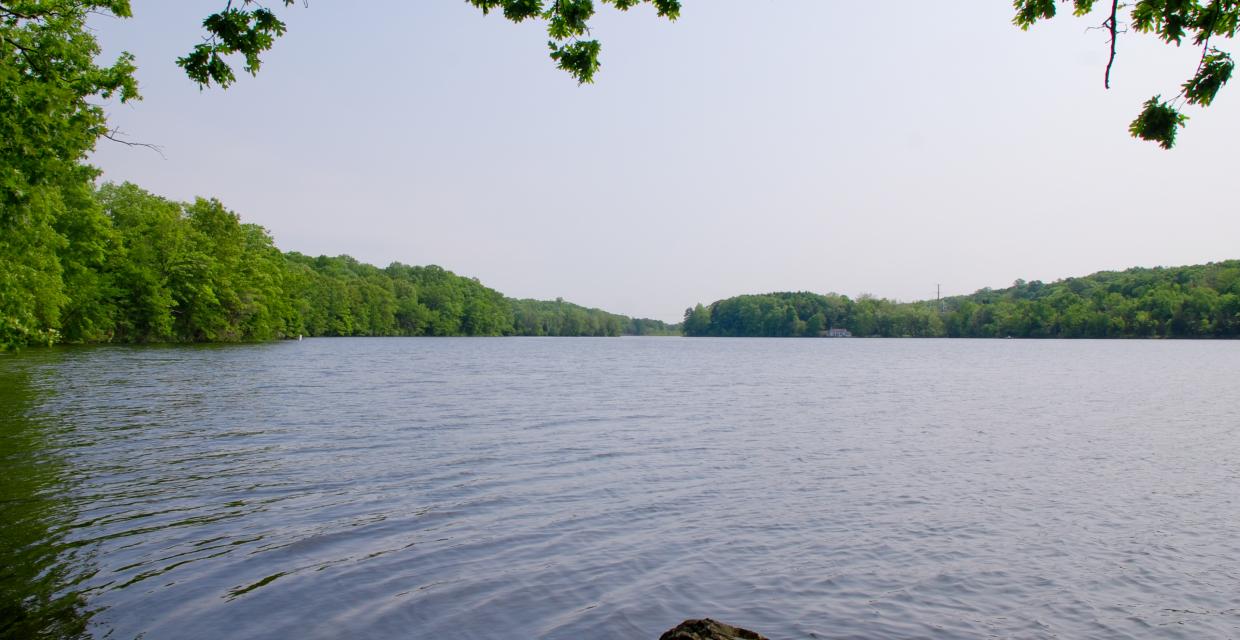
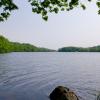
This loop hike follows the shore of Lake Aeroflex and runs along the Sussex Branch Rail-Trail.
Hike Checklist:
Whether you are going for a day hike or backpacking overnight, it is good practice to carry what we call The Hiking Essentials. These essentials will help you enjoy your outing more and will provide basic safety gear if needed. There may also be more essentials, depending on the season and your needs.
The Essentials
Hiking Shoes or Boots
Water - Two quarts per person is recommended in every season. Keep in mind that fluid loss is heightened in winter as well as summer. Don't put yourself in the position of having to end your hike early because you have run out of water.
Map - Know where you are and where you are going. Many of our hiking areas feature interconnecting network of trails. Use a waterproof/tear-resistant Tyvek Trail Conference map if available or enclose your map in a Ziplock plastic bag. If you have a mobile device, download Avenza’s free PDF Maps app and grab some GPS-enhanced Trail Conference maps (a backup Tyvek or paper version of the map is good to have just in case your batteries die or you don't have service). Check out some map-reading basics here.
Food - Snacks/lunch will keep you going as you burn energy walking or climbing. Nuts, seeds, and chocolate are favorites on the trail.
Sunscreen and insect repellent
Rain Gear and Extra Clothing - Rain happens. So does cold. Be prepared for changing weather. Avoid cotton--it traps water against your skin and is slow to dry. If you are wearing wet cotton and must return to your starting point, you risk getting chills that may lead to a dangerous hypothermia. Choose synthetic shirts, sweaters and/or vests and dress in layers for easy on and off.
Compass - A simple compass is all you need to orient you and your map to magnetic north.
Light - A flashlight or small, lightweight headlamp will be welcome gear if you find yourself still on the trail when darkness falls. Check the batteries before you start out and have extras in your pack.
First Aid Kit - Keep it simple, compact, and weatherproof. Know how to use the basic components.
Firestarter and Matches - In an emergency, you may need to keep yourself or someone else warm until help arrives. A firestarter (this could be as simple as leftover birthday candles that are kept inside a waterproof container) and matches (again, make sure to keep them in a waterproof container) could save a life.
Knife or Multi-tool - You may need to cut a piece of moleskin to put over a blister, repair a piece of broken equipment, or solve some other unexpected problem.
Emergency Numbers - Know the emergency numbers for the area you're going to and realize that in many locations--especially mountainous ones, your phone will not get reception.
Common Sense - Pay attention to your environment, your energy, and the condition of your companions. Has the weather turned rainy? Is daylight fading? Did you drink all your water? Did your companion fail to bring rain gear? Are you getting tired? Keep in mind that until you turn around you are (typically) only half-way to completing your hike--you must still get back to where you started from! (Exceptions are loop hikes.)
Check the weather forecast before you head out. Know the rules and regulations of the area.
The Leave No Trace Seven Principles
Plan Ahead and Prepare
- Know the regulations and special concerns for the area you'll visit.
- Prepare for extreme weather, hazards, and emergencies.
- Schedule your trip to avoid times of high use.
- Visit in small groups when possible. Consider splitting larger groups into smaller groups.
- Repackage food to minimize waste.
- Use a map and compass to eliminate the use of marking paint, rock cairns or flagging.
Travel and Camp on Durable Surfaces
- Durable surfaces include established trails and campsites, rock, gravel, dry grasses or snow.
- Protect riparian areas by camping at least 200 feet from lakes and streams.
- Good campsites are found, not made. Altering a site is not necessary.
- In popular areas:
- Concentrate use on existing trails and campsites.
- Walk single file in the middle of the trail, even when wet or muddy.
- Keep campsites small. Focus activity in areas where vegetation is absent.
- In pristine areas:
- Disperse use to prevent the creation of campsites and trails.
- Avoid places where impacts are just beginning.
- Pack it in, pack it out. Inspect your campsite and rest areas for trash or spilled foods. Pack out all trash, leftover food and litter.
- Deposit solid human waste in catholes dug 6 to 8 inches deep, at least 200 feet from water, camp and trails. Cover and disguise the cathole when finished.
- Pack out toilet paper and hygiene products.
- To wash yourself or your dishes, carry water 200 feet away from streams or lakes and use small amounts of biodegradable soap. Scatter strained dishwater.
- Preserve the past: examine, but do not touch cultural or historic structures and artifacts.
- Leave rocks, plants and other natural objects as you find them.
- Avoid introducing or transporting non-native species.
- Do not build structures, furniture, or dig trenches.
- Campfires can cause lasting impacts to the backcountry. Use a lightweight stove for cooking and enjoy a candle lantern for light.
- Where fires are permitted, use established fire rings, fire pans, or mound fires.
- Keep fires small. Only use sticks from the ground that can be broken by hand.
- Burn all wood and coals to ash, put out campfires completely, then scatter cool ashes.
- Observe wildlife from a distance. Do not follow or approach them.
- Never feed animals. Feeding wildlife damages their health, alters natural behaviors, and exposes them to predators and other dangers.
- Protect wildlife and your food by storing rations and trash securely.
- Control pets at all times, or leave them at home.
- Avoid wildlife during sensitive times: mating, nesting, raising young, or winter.
Be Considerate of Other Visitors
- Respect other visitors and protect the quality of their experience.
- Be courteous. Yield to other users on the trail.
- Step to the downhill side of the trail when encountering pack stock.
- Take breaks and camp away from trails and other visitors.
- Let nature's sounds prevail. Avoid loud voices and noises.
The Trail Conference is a 2015 Leave No Trace partner.
(c) Leave No Trace Center for Outdoor Ethics: www.LNT.org.


